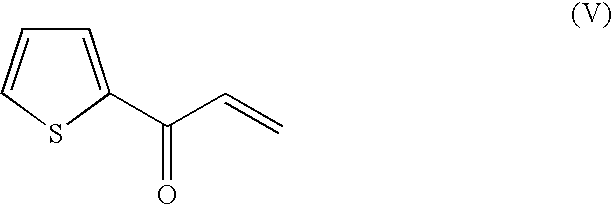Enzymatic Reduction for Producing Optically Active Alcohols
a technology of optically active alcohol and enzymatic reduction, which is applied in the direction of biochemistry, organic chemistry, biochemical apparatus and processes, etc., can solve the problem of stable sensitivity of lah-lcb reduction system
- Summary
- Abstract
- Description
- Claims
- Application Information
AI Technical Summary
Benefits of technology
Problems solved by technology
Method used
Image
Examples
example 1
Analysis of 3-chloro-1-(thien-2-yl)propan-1-one and 3-chloro-1-(thien-2-yl)propan-1-ol
[0134]The concentrations of 3-chloro-1-(thien-2-yl)propan-1-one and 3-chloro-1-(thien-2-yl)propan-1-ol can be determined by means of HPLC. It is also possible, depending on the choice of stationary and mobile phases, to determine the ee value in addition to the concentration.
a) Achiral Analysis
[0135]The reaction was quantified using the following system:
Stationary phase:Chromoltih SpeedROD RP18, 50 * 4,6 μm, Merck (Darmstadt, Germany),heated to 45° C.Mobile phase:Eluent A: 10 mM KH2PO4, pH 2.5Eluent B: acetonitrileGradient: 0-0.5 min, 35% B; 0.5-1.0 min 35 to 80% B;1.0-1.2 min80% B; 1.2-1.3 min 80%-35% B; 1.3-2.0 min 35% B;Flow rate:1.5 ml / minDetection:UV detection at 230 and 260 nmRetention times:3-chloro-1-(thien-2-yl)propan-1-one: approx. 1.6 min3-chloro-1-(thien-2-yl)propan-1-ol: approx. 1.3 min
[0136]Using authentic material, a calibration series is produced, on the basis of which the concentra...
example 2
Provision of Glucose Dehydrogenase for Cofactor Regeneration
[0139]Glucose dehydrogenase may be used for cofactor regeneration. The enzyme can be obtained from commercial sources (e.g. Jülich Fine Chemicals Order No. 22.10 or 19.10) or else may readily be prepared based on the known DNA sequence. An E. coli XL10 Gold clone which comprises the Bacillus subtilis glucose dehydrogenase gene (Genbank Acc. No. M12276) in the pUC19 plasmid was used; this construct is referred to as E. coli LU11293.
[0140]The following medium was prepared for fermentation of E. coli LU11293:
560gYeast extract (65%)448gTrypton (Difco)42gKH2PO484gNa2HPO4644gGlycerol (99%)100mlSL4 solution (5 x)1gTegosipon 3062Dilute medium with water to 13.5 I, adjust pH to 7.0,remove approx. 300 ml for preculture, then sterilizeat 122° C. for 30 min.Add sterile salt solution* (remove the salt solution forthe shaker flasks beforehand, see protocol).*Salt solution:2.1 gCaCl2 * 2H2O3.5 gMgSO4 * 7H2O14 gNH4Cl14 mlAmpicillin solutio...
example 3
Cofactor Regeneration
[0142]The cofactor may also be regenerated by the dehydrogenase which causes the conversion of alkanones (II) to alkanols (I). In this case, addition of a separate regeneration enzyme is not required. The dehydrogenase accepts various monohydric alcohols as reducing agents. They are oxidized to the corresponding carbonyl compounds. A monohydric alcohol which is suitable for regenerating NADH with dehydrogenase is isopropanol. 10% isopropanol is used instead of glucose dehydrogenase and glucose in the reaction mixture.
PUM
| Property | Measurement | Unit |
|---|---|---|
| temperature | aaaaa | aaaaa |
| pH | aaaaa | aaaaa |
| pH | aaaaa | aaaaa |
Abstract
Description
Claims
Application Information
 Login to View More
Login to View More - R&D
- Intellectual Property
- Life Sciences
- Materials
- Tech Scout
- Unparalleled Data Quality
- Higher Quality Content
- 60% Fewer Hallucinations
Browse by: Latest US Patents, China's latest patents, Technical Efficacy Thesaurus, Application Domain, Technology Topic, Popular Technical Reports.
© 2025 PatSnap. All rights reserved.Legal|Privacy policy|Modern Slavery Act Transparency Statement|Sitemap|About US| Contact US: help@patsnap.com



